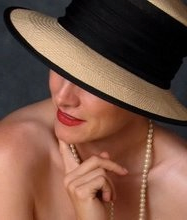Well, I think we know. They ALL do. Seventy-five percent of adult American women color their hair. We brush it, blow it, cut it, curl it, shampoo it, treat it, perm it, straighten it...but most of all we dye it.
 Hair worship has been a part of Hollywood since film began. Technicolor became more affordable in the '50s and when Clairol simultaneously introduced the first one-step lightener and tint, dye jobs became a hit with just plain folks. "Does She or Doesn't She?" ads convinced fashion-conscious homemakers for the first time that it was alright to color their hair.
Hair worship has been a part of Hollywood since film began. Technicolor became more affordable in the '50s and when Clairol simultaneously introduced the first one-step lightener and tint, dye jobs became a hit with just plain folks. "Does She or Doesn't She?" ads convinced fashion-conscious homemakers for the first time that it was alright to color their hair. Very few of those technicolor queens wore their real color on screen. The most famous of the natural redheads were Katharine Hepburn, the first freckle-faced, red-haired actress to become a major star, and Maureen O'Hara (87). (Lucille Ball self-described her natural color as "mousy brown." Ann-Margret (66) came into the world a brunette, ditto Rita Hayworth.) The first redhead was actually a genetic error originating 20,000 to 40,000 years ago. Red hair appears in people with two copies of a recessive gene on chromosome 16, causing a mutated MC1R protein. It's the rarest natural hair color in humans.
Very few of those technicolor queens wore their real color on screen. The most famous of the natural redheads were Katharine Hepburn, the first freckle-faced, red-haired actress to become a major star, and Maureen O'Hara (87). (Lucille Ball self-described her natural color as "mousy brown." Ann-Margret (66) came into the world a brunette, ditto Rita Hayworth.) The first redhead was actually a genetic error originating 20,000 to 40,000 years ago. Red hair appears in people with two copies of a recessive gene on chromosome 16, causing a mutated MC1R protein. It's the rarest natural hair color in humans.Today's stars regularly go from light to dark and back again. It's nearly impossible to name one film actress who has maintained her natural hair color. Or even to name her natural hair color.
 Male actors like Brad Pitt (44) change hair color frequently, but always ostensibly for a role. Richard Gere (58) and George Clooney (46) opt for greying naturally.
Male actors like Brad Pitt (44) change hair color frequently, but always ostensibly for a role. Richard Gere (58) and George Clooney (46) opt for greying naturally. Let's pick on Nicole Kidman (40). Naturally ginger, she went really deep red with her Moulin Rouge hair, then auburn, then the blond Bewitched stage, and now strawberry blond (usually). Kidman's gone grey, hence the chemical blonde-ing of her natural red. Look at the temple area where the grey takes the hair dye poorly. Being overly thin is a disadvantage: the hair falls out and gets dull (pregnancy hormones will temporarily help). She almost always appears on-screen and at galas with hair helpers in place (look for the bangs that often disguise the lace-front wig hairline).
Let's pick on Nicole Kidman (40). Naturally ginger, she went really deep red with her Moulin Rouge hair, then auburn, then the blond Bewitched stage, and now strawberry blond (usually). Kidman's gone grey, hence the chemical blonde-ing of her natural red. Look at the temple area where the grey takes the hair dye poorly. Being overly thin is a disadvantage: the hair falls out and gets dull (pregnancy hormones will temporarily help). She almost always appears on-screen and at galas with hair helpers in place (look for the bangs that often disguise the lace-front wig hairline).



And remember when "Highlights" used to be a magazine for kids? The NYTimes recently meant something entirely different in A Girl's Life, With Highlights. Lest you think the article celebrated intellectual or emotional empowerment in some way, let's be clear: it was enumerating hair. That's right, highlights as in hair. For the pre-teen crowd. Today's on-screen "tween" role models like Hanna Montana or Miley Cyrus aren't the least bit girlish about their hair (or scripted sexual histrionics).
 Young celebrities change their hair color as often as their shoes.
Young celebrities change their hair color as often as their shoes.Most of my generation grew up with pink or blue-haired grandmothers. Our own mothers dabbled in color, but took to their grey with menopause. Less than 60 years ago only 7 percent of American women dyed to hide their gray. But for a middle aged woman today? Grey? Almost anachronistic!
What do we think when we see a man in a salon chair, his hair up in foils? Narcissistic? Gay? Or the aging Lothario covering his grey, ala The Donald? Why does it strike our eye as so odd (and desperate) for an aging man, but normal for a middle-aged woman? Men can go grey and be cool. But when was the last time you saw a sexy grey-haired woman in a movie?
Now, if you'll excuse me I'm off to get my hair colored.
